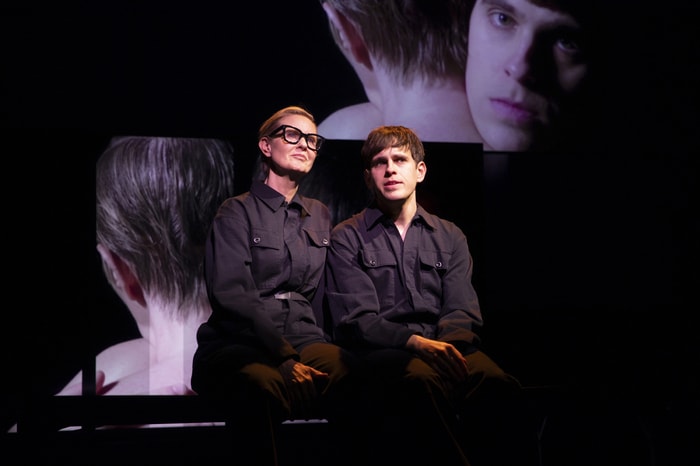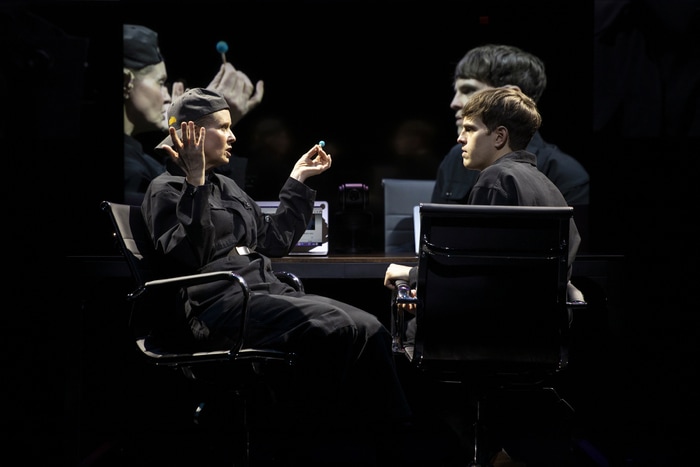After her son and manager Naphtali books his single mom and world-renowned performance artist Miriam for a show at MoMA, she suddenly goes missing. Upon her unexpected return seven years later, she offers few answers about where she was and why she left, but doesn’t hesitate to express her inveterate expectation of him in The New Group’s Off-Broadway world premiere of the nonlinear coming-of-age memory play The Seven Year Disappear at Pershing Square Signature Center.

Written by Jordan Seavey and directed by Scott Elliott, the two-hander stars Cynthia Nixon in her formidable return to The New Group and Taylor Trensch in a deeply affecting debut with the company. Nixon not only appears in the role of Miriam, but as eight other characters in the life of Naph, who was abandoned by her without a word, left to fend for himself, and to find love, comfort, and purpose with others – friends, lovers, and colleagues in his shift from the art world to political endorsement and LGBTQ advocacy – all surrogates for the absentee mother he sees in them (as suggested in the meaningful casting). Adding to his feelings of isolation is a father he never knew and was told nothing about by the ego-driven Miriam, who sees life, and exploits him, as fodder for her durational performance art pieces, in a critical look at our post-modern age of incessant documentation and oversharing of what should be private, for public consumption and narcissistic gratification.
When the house opens, the actors are already seated at opposite ends of a table on the darkened stage (minimalist set by Derek McLane), unmoving and silent, as if they’re one of her all-consuming works of art, with huge multiple projections of the name “MIRIAM” behind them (projections by John Narun). A pre-show timeline of the themes and dates also runs across the back wall of video screens, to aid the audience in following along with the narrative. The story is then presented as a series of scenes in an achronological configuration, with the title of each individual segment projected at stage right, large-scale close-up images and live-feed videos of the figures upstage, and the actors often speaking at floor microphones, which again evoke the conceptual stylings of performance art, the overarching importance of the show’s artistic design, and Oscar Wilde’s observation that “life imitates art far more than art imitates life.”

Along with name-dropping references to the famous artists who influenced Miriam and with whom she laughably competes, the momentous topics discussed and enacted range from the meaning of art to the 2016 presidential election, from sexual encounters to HIV and AIDS, with gradual reveals that give us insights into the psychology and backgrounds of the characters and their relationships, in a compelling combination of humor, drama, and mystery.
Nixon switches seamlessly from one role to the next, changing genders, ages, and accents (with Deborah Hecht serving as dialect coach), donning a pair of glasses or a baseball cap, and varying her demeanor, and, in her mother-and-son dialogues, raising the decibel level, anger, and manipulation of Naphtali (which, he tells us, is Hebrew for “my struggle, my strife”). Trensch turns in a heartrending portrayal of the damaged gay son, who argues back, admits he’s “fucked up” because of her, has too often been left alone, but is now “a different person than he was seven years ago.” Or is he still under her control and a participant in her art?

Both actors wear the same long-sleeve black overalls and heavy construction boots throughout the different scenes and dates (costumes by Qween Jean), which blend with the mostly black-and-white design, offer no distraction from their expressive faces, voices, hands, and movements (fight and intimacy direction by UnkleDave’s Fight-House), and reinforce the format of the show as an exhibition by performance artists, enhanced by clear sound by Rob Milburn and Michael Bodeen and lighting by Jeff Croiter that signals the shifts in scenes.
The Seven Year Disappear is an engaging and provocative exploration of the significance of art and its impact on both the artists who create it and the culture it represents, with a level of artistry, performance, and intrigue that are of the highest standards and make for a thoroughly captivating production.
Running Time: Approximately 90 minutes, without intermission.
The Seven Year Disappear plays through Sunday, March 31, 2024, at The New Group, performing at Pershing Square Signature Center, 480 West 42nd Street, NYC. For tickets (priced at $72-112, including fees), call (917) 935-4242), or go online.






The New Group, in partnership with The League of Live Stream Theater (a non-profit organization), will livestream the final Off-Broadway performances of the The Seven Year Disappear on Friday, March 29, at 7:30 pm, Saturday, March 30, at 2:00 pm and 8:00 pm, and Sunday, March 31, at 2:00 pm. Livestream tickets are currently available for $69 at thenewgroup.org.